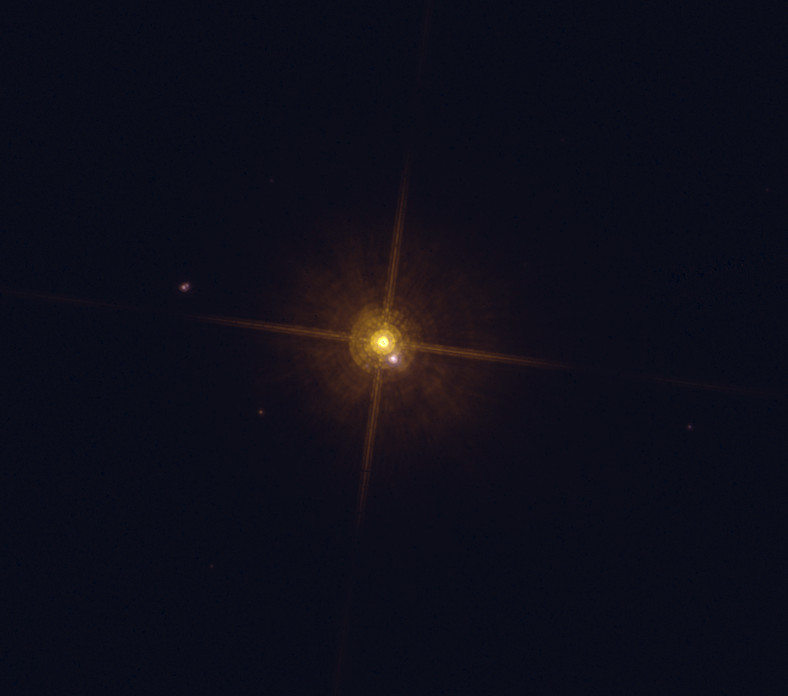|
X Cancri
X Cancri is a variable star in the northern constellation of Cancer. It has a red hue and is visible to the naked eye at its brightest. The distance to this object is approximately 1,860 light years based on parallax measurements, but is drifting closer with a radial velocity of −5 km/s. It lies very close to the ecliptic and so is subject to lunar occultations. This object is a carbon staran aging red giant star on the asymptotic giant branch that has a higher abundance of carbon than oxygen in its atmosphereand is one of the brightest carbon stars in the sky. It has a carbon star spectral classification of C-N4.5 C25.5 MS3. The first C indicates that it is a carbon star, and the N5 that it is a fairly cool strongly red AGB star. The C2 index indicates the strength of the Swan bands on a scale of one to eight, which shows the relative abundance of carbon vs oxygen. The MS index, not to be confused with an MS spectral class, indicates the strength of th ... [...More Info...] [...Related Items...] OR: [Wikipedia] [Google] [Baidu] |
Cancer (constellation)
Cancer is one of the twelve constellations of the zodiac and is located in the Northern celestial hemisphere. Its old astronomical symbol is (♋︎). Its name is Latin for crab and it is commonly represented as one. Cancer is a medium-size constellation with an area of 506 square degrees and its stars are rather faint, its brightest star Beta Cancri having an apparent magnitude of 3.5. It contains two stars with known planets, including 55 Cancri, which has five: one super-earth and four gas giants, one of which is in the habitable zone and as such has expected temperatures similar to Earth. At the (angular) heart of this sector of our celestial sphere is Praesepe (Messier 44), one of the closest open clusters to Earth and a popular target for amateur astronomers. Characteristics Cancer is a medium-sized constellation that is bordered by Gemini to the west, Lynx to the north, Leo Minor to the northeast, Leo to the east, Hydra to the south, and Canis Minor to the south ... [...More Info...] [...Related Items...] OR: [Wikipedia] [Google] [Baidu] |
Stellar Atmosphere
The stellar atmosphere is the outer region of the volume of a star, lying above the stellar core, radiation zone and convection zone. Overview The stellar atmosphere is divided into several regions of distinct character: * The photosphere, which is the atmosphere's lowest and coolest layer, is normally its only visible part. Light escaping from the surface of the star stems from this region and passes through the higher layers. The Sun's photosphere has a temperature in the 5,770 K to 5,780 K range. Starspots, cool regions of disrupted magnetic field lie on the photosphere. * Above the photosphere lies the chromosphere. This part of the atmosphere first cools down and then starts to heat up to about 10 times the temperature of the photosphere. * Above the chromosphere lies the transition region, where the temperature increases rapidly on a distance of only around 100 km. * The outermost part of the stellar atmosphere is the corona, a tenuous plasma which ha ... [...More Info...] [...Related Items...] OR: [Wikipedia] [Google] [Baidu] |
Hipparcos Objects
''Hipparcos'' was a scientific satellite of the European Space Agency (ESA), launched in 1989 and operated until 1993. It was the first space experiment devoted to precision astrometry, the accurate measurement of the positions of celestial objects on the sky. This permitted the first high-precision measurements of the intrinsic brightnesses (compared to the less precise apparent brightness), proper motions, and parallaxes of stars, enabling better calculations of their distance and tangential velocity. When combined with radial velocity measurements from spectroscopy, astrophysicists were able to finally measure all six quantities needed to determine the motion of stars. The resulting ''Hipparcos Catalogue'', a high-precision catalogue of more than 118,200 stars, was published in 1997. The lower-precision ''Tycho Catalogue'' of more than a million stars was published at the same time, while the enhanced Tycho-2 Catalogue of 2.5 million stars was published in 2000. ''Hipp ... [...More Info...] [...Related Items...] OR: [Wikipedia] [Google] [Baidu] |
Henry Draper Catalogue Objects
Henry may refer to: People *Henry (given name) *Henry (surname) * Henry Lau, Canadian singer and musician who performs under the mononym Henry Royalty * Portuguese royalty ** King-Cardinal Henry, King of Portugal ** Henry, Count of Portugal, Henry of Burgundy, Count of Portugal (father of Portugal's first king) ** Prince Henry the Navigator, Infante of Portugal ** Infante Henrique, Duke of Coimbra (born 1949), the sixth in line to Portuguese throne * King of Germany **Henry the Fowler (876–936), first king of Germany * King of Scots (in name, at least) ** Henry Stuart, Lord Darnley (1545/6–1567), consort of Mary, queen of Scots ** Henry Benedict Stuart, the 'Cardinal Duke of York', brother of Bonnie Prince Charlie, who was hailed by Jacobites as Henry IX * Four kings of Castile: **Henry I of Castile **Henry II of Castile **Henry III of Castile **Henry IV of Castile * Five kings of France, spelt ''Henri'' in Modern French since the Renaissance to italianize the name and to ... [...More Info...] [...Related Items...] OR: [Wikipedia] [Google] [Baidu] |
Durchmusterung Objects
In astronomy, Durchmusterung or Bonner Durchmusterung (BD) is an astrometric star catalogue of the whole sky, compiled by the Bonn Observatory in Germany from 1859 to 1903. The name comes from ('run-through examination'), a German word used for a systematic survey of objects or data. The term has sometimes been used for other astronomical surveys, including not only stars, but also the search for other celestial objects. Special tasks include celestial scanning in electromagnetic wavelengths shorter or longer than visible light waves. Original catalog The 44 years of work on the Bonner Durchmusterung (abbreviated BD), initiated by Friedrich Argelander and largely carried out by his assistants, resulted in a catalogue of the positions and apparent magnitudes of approximately 325,000 stars to apparent magnitude 9–10. The catalogue was accompanied by charts plotting the positions of the stars, and was the basis for the ''Astronomische Gesellschaft Katalog'' (AGK) and '' Smith ... [...More Info...] [...Related Items...] OR: [Wikipedia] [Google] [Baidu] |
Semiregular Variable Stars
In astronomy, a semiregular variable star, a type of variable star, is a giant or supergiant of intermediate and late (cooler) spectral type showing considerable periodicity in its light changes, accompanied or sometimes interrupted by various irregularities. Periods lie in the range from 20 to more than 2000 days, while the shapes of the light curves may be rather different and variable with each cycle. The amplitudes may be from several hundredths to several magnitudes (usually 1-2 magnitudes in the V filter). Classification The semiregular variable stars have been sub-divided into four categories for many decades, with a fifth related group defined more recently. The original definitions of the four main groups were formalised in 1958 at the tenth general assembly of the International Astronomical Union (IAU). The General Catalogue of Variable Stars (GCVS) has updated the definitions with some additional information and provided newer reference stars where old examples such a ... [...More Info...] [...Related Items...] OR: [Wikipedia] [Google] [Baidu] |
Carbon Stars
A carbon star (C-type star) is typically an asymptotic giant branch star, a luminous red giant, whose atmosphere contains more carbon than oxygen. The two elements combine in the upper layers of the star, forming carbon monoxide, which consumes most of the oxygen in the atmosphere, leaving carbon atoms free to form other carbon compounds, giving the star a "sooty" atmosphere and a strikingly ruby red appearance. There are also some dwarf and supergiant carbon stars, with the more common giant stars sometimes being called classical carbon stars to distinguish them. In most stars (such as the Sun), the atmosphere is richer in oxygen than carbon. Ordinary stars not exhibiting the characteristics of carbon stars but cool enough to form carbon monoxide are therefore called oxygen-rich stars. Carbon stars have quite distinctive spectral characteristics, and they were first recognized by their spectra by Angelo Secchi in the 1860s, a pioneering time in astronomical spectroscopy. Spec ... [...More Info...] [...Related Items...] OR: [Wikipedia] [Google] [Baidu] |
Very Long Baseline Interferometry
Very-long-baseline interferometry (VLBI) is a type of astronomical interferometry used in radio astronomy. In VLBI a signal from an astronomical radio source, such as a quasar, is collected at multiple radio telescopes on Earth or in space. The distance between the radio telescopes is then calculated using the time difference between the arrivals of the radio signal at different telescopes. This allows observations of an object that are made simultaneously by many radio telescopes to be combined, emulating a telescope with a size equal to the maximum separation between the telescopes. Data received at each antenna in the array include arrival times from a local atomic clock, such as a hydrogen maser. At a later time, the data are correlated with data from other antennas that recorded the same radio signal, to produce the resulting image. The resolution achievable using interferometry is proportional to the observing frequency. The VLBI technique enables the distance betwee ... [...More Info...] [...Related Items...] OR: [Wikipedia] [Google] [Baidu] |
Fourier Analysis
In mathematics, Fourier analysis () is the study of the way general functions may be represented or approximated by sums of simpler trigonometric functions. Fourier analysis grew from the study of Fourier series, and is named after Joseph Fourier, who showed that representing a function as a sum of trigonometric functions greatly simplifies the study of heat transfer. The subject of Fourier analysis encompasses a vast spectrum of mathematics. In the sciences and engineering, the process of decomposing a function into oscillatory components is often called Fourier analysis, while the operation of rebuilding the function from these pieces is known as Fourier synthesis. For example, determining what component frequencies are present in a musical note would involve computing the Fourier transform of a sampled musical note. One could then re-synthesize the same sound by including the frequency components as revealed in the Fourier analysis. In mathematics, the term ''Fourier a ... [...More Info...] [...Related Items...] OR: [Wikipedia] [Google] [Baidu] |
MS Star (spectral Type)
An S-type star (or just S star) is a cool giant with approximately equal quantities of carbon and oxygen in its atmosphere. The class was originally defined in 1922 by Paul Merrill for stars with unusual absorption lines and molecular bands now known to be due to s-process elements. The bands of zirconium monoxide (ZrO) are a defining feature of the S stars. The carbon stars have more carbon than oxygen in their atmospheres. In most stars, such as class M giants, the atmosphere is richer in oxygen than carbon and they are referred to as ''oxygen-rich stars''. S-type stars are intermediate between carbon stars and normal giants. They can be grouped into two classes: ''intrinsic'' S stars, which owe their spectra to convection of fusion products and s-process elements to the surface; and ''extrinsic'' S stars, which are formed through mass transfer in a binary system. The intrinsic S-type stars are on the most luminous portion of the asymptotic giant branch, a stage of thei ... [...More Info...] [...Related Items...] OR: [Wikipedia] [Google] [Baidu] |
Swan Band
Swan bands are a characteristic of the spectra of carbon stars, comets and of burning hydrocarbon fuels. They are named for the Scottish physicist William Swan, who first studied the spectral analysis of radical diatomic carbon (C2) in 1856. Swan bands consist of several sequences of vibrational bands scattered throughout the visible spectrum. See also *Spectroscopy Spectroscopy is the field of study that measures and interprets the electromagnetic spectra that result from the interaction between electromagnetic radiation and matter as a function of the wavelength or frequency of the radiation. Matter ... References Emission spectroscopy Fire Astronomical spectroscopy Astrochemistry Carbon {{Spectroscopy-stub ... [...More Info...] [...Related Items...] OR: [Wikipedia] [Google] [Baidu] |







.png)
